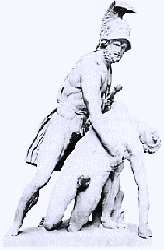|
|
 |
|
Dirme, Pasquino |
|
written
by kaia chessen / 07.04.2004 |
|
|
| |
Location |
| |
| |

|
|
| Pasquino |
|
| |
|
La Piazza de' Pasquino is molto vecino al Campo de' Fiori. Simply cross Vittorio Emanuele across the first crosswalk you see and you'll arrive at a tiny square with a large bronze statue of some guy who was probably rich and important. Look to your right and you'll see a large Palazzo with a sign designating it Il Museo de Roma. Follow the street to the left of this building and you're there. Immediately on your left is the infamous "talking" statue, Pasquino.
|
| |
|
| |
|
| |
Description |
| |
Il Piazza de' Pasquino is a small square, sandwiched in-between large buildings, apartments, and restaurants. In extreme proximity to la Piazza Navona (and Kaia and Megan's apartment on Via dei Leutari), the Piazza is anymore mainly used as a parking lot. The real function of Il Piazza de' Pasquino, however, is to serve as a home to the statue of Pasquino, the first form of Roman journalism, subject of ancient controversy and scandal, the talking statue.
|
| |
|
| |
|
| |
Story of Discovery |
| |
I had read about Pasquino before our visit to Roma, wrongfully informed that it was IN the Piazza Navona instead of simply nearby. I searched for it many times in vain and asked several clueless locals and even a tour guide before I stumbled on it randomly on my own.
|
| |
|
| |
|
| |
Element of Interest |
| |
Pasquino was the first form of Roman journalism. Before Romans were allowed freedom of speech under papal rule, the brave and politically skeptical would sneak to La Piazza de' Pasquino during the middle of the night and with a hammer and chisel, scrawl their feelings about the government and the pope himself, along the base of the statue. In the morning, locals would pass by and read what political rantings and humor had been etched the night before. The news would spread around the city and on the following night, others would come with their own chiseling equipment and scribe their own responses. The pope was not happy about the insults directed at him which this statue invited and so several times offered a reward for the author of such messages. Once, a man named Pasquino turned himself in, greedily hoping for the cash reward, but could not carry it home with him. When he turned himself in, the pope's men cut off both his hands. The statue is now named for this handless journalist.
In other attempts to deter the spread of opinions which clashed with his own, the pope tried several times to have the Pasquino statue thrown in the river. He failed. However, you'll notice Pasquino has taken quite a beating over time. The poor statue has no arms or face... a perfect tablet for political inscriptions.
Today, hundreds of years later, Pasquino's still in use. His base is draped with articles, political cartoons, and poetry.
|
| |
|
| |
|
| |
Image |
| |
| |

|
|
| Pasquino as it was |
|
| |
|
This image of Pasquino is a depiction of what the statue may have looked like in its original state. It was discovered in 1501 and many theories have been made about whom it may have depicted. Michaelangelo's theory, however, is the one followed in this picture. His hypothesis was that the statue was of two characters from Homer's Iliad: Menelao dragging the dying body of Patroclo. Anymore, it's difficult to decipher one figure in Pasquino, let alone two.
|
| |
|
| |
|
|
 |
|
